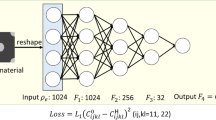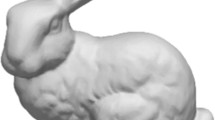Abstract
Contemporary design process requires the development of a new computational intelligence or soft computing methodology that involves intelligence integration and hybrid intelligent systems for design, analysis and evaluation, and optimization. This paper first presents a discussion of the need to incorporate “intelligence” into an automated design process and the various constraints that designers face when embarking on industrial design projects. Then, it presents the design problem as optimizing the design output against constraints and the use of soft computing and hybrid intelligent systems techniques. In this paper, a soft-computing-integrated intelligent design framework is developed. A hybrid dual cross-mapping neural network (HDCMNN) model is proposed using the hybrid soft computing technique based on “cross-mapping” between a back-propagation network (BPNN) and a recurrent Hopfield network (HNN) for supporting modeling, analysis and evaluation, and optimization tasks in the design process. The two networks perform different but complementary tasks—the BPNN “decides” if the design problem is a “type 0” (rational) or “type 1” (non-rational) problem, and the output layer weights are then used as the energy function for the HNN. The BPNN is used for representing design patterns, training classification boundaries, and outputting network weight values to the HNN, and then the HNN uses the calculated network weight values to evaluate and modify or re-design the design patterns. The developed system provides a unified soft-computing-integrated intelligent design framework with both symbolic and computational intelligence. The system has self-modifying and self-learning functions. Within the system, only one network training is needed for accomplishing the evaluation, rectification/modification, and optimization tasks in the design process. Finally, two case studies are provided to illustrate and validate the developed model and system.









Similar content being viewed by others
References
Arai E, Iwata K (1992) Product modeling system in conceptual design of mechanical products. Robotics Comput Int Manuf 9(4–5):327–334
Azoff EM (1994) Neural network time series: forecasting of financial markets. Wiley, New York
Bateman RE, Bowden RG, Gogg TJ, Harrell CR, Mott JRA (1997) System improvement using simulation, 5th edn. Promodel Corporation, Orem, Utah
Braun WJ, Reboller R, Schiller EF (1996) Computer aided planning and design of manual assembly systems. Int J Prod Res 34(8):2317–2333
Chen CLP, Yan QW (1991) Design of a case associative assembly planning system. In: Dagli CH, Kumara SRY, YC Shin (eds) Intelligent engineering systems through artificial neural networks. ASME Press, New York, pp 757–762
Cheung JY (1994) Scheduling. In: Dagli CH (ed) Artificial neural networks for intelligent manufacturing. Chapman and Hall, London, pp 159–193
Chovan JD, Waldron MB (1991) Towards intelligent CAD: a neural network model of the transformation from perception to function in mechanical engineering design. In: Dagli CH, Kumara SRT, Shin YC (eds) Intelligent engineering systems through artificial neural networks. ASME Press, New York, pp 751–756
Chryssolouris G, Lee M, Pierce J (1990) Use of neural networks for the design of manufacturing systems. Manuf Rev 3(3):187–194
Coyne RD, Postmus AG (1990) Spatial application of neural networks in computer aided design. Artif Intell Eng 5(1):9–22
Dagli CH (1994) Artificial neural networks for intelligent manufacturing. Chapman and Hall, London
Dagli CH, Huggahalli R (1993) A neural network approach to group technology. In: Wang J, Takefuji Y (eds) Neural networks in design and manufacturing. World Scientific, Singapore, pp 1–54
Dhingra AK, Rao SS (1992) A neural network based approach to mechanical design optimization. Eng Optimiz 20:187–233
Goonatilake S, Khebbal S (1995) Intelligent hybrid systems. Wiley, New York
Henderson MR (1994) Manufacturing feature identification. In: Dagli CH (ed) Artificial neural networks for intelligent manufacturing. Chapman and Hall, London, pp 229–264
Ho NC, Lim TE (1990) Computer-aided workplace layout and line balancing. In: Karwowski W, Genaidy AM, Asfour SS (eds) Computer-aided ergonomics: a researcher’s guide. Taylor and Francis, London
Hong DS, Cho HS (1995) A neural-network-based computational scheme for generating optimized robotic assembly sequences. Eng Appl Artif Intell 8(2):129–145
Hou ESH, Ansari N, Ren H (1994) A genetic algorithm for multiprocessor scheduling. IEEE Trans Parall Distr Syst 5(2):113–120
Jung ES, Park SJ (1994) Prediction of human reach posture using a neural network for ergonomic man models. Comput Ind Eng 27(1–4):369–372
Kamarathi SV, Kumara SRT (1993) Neural networks in conceptual design. In: Wang J, Takefuji Y (eds) Neural networks in design and manufacturing. World Scientific, Singapore, pp 99–120
Kamarthi SV, Kumara ST, Yu FTS, Ham I (1990) Neural networks and their applications in component design data retrieval. J Intell Manuf 1(2):125–140
Kang SY (1991) An investigation of the use of feedforward neural networks for forecasting. PhD thesis, Kent State University, Ohio
Kim JO (1992) Task-based kinematic design of robot manipulators. PhD thesis, Carnegie Mellon University, Pittsburgh, Pennsylvania
Kohonen T (1988) An introduction to neural computing. Neural Netw 1:3–16
Kumara SRT, Ham I (1990) Use of associative memory and self organization in conceptual design. Ann CIRP 39(1):117–120
Kumara SRT, Kamarthi SV (1991) Function-to-structure transformation in conceptual design: an associative memory-based paradigm. J Intell Manuf 2(5):281–292
Kusiak A, Lee H (1996) Neural computing-based design of components for cellular manufacturing. Int J Prod Res 34(7):1777–1790
Law AM, Kelton WD (1991) Simulation modeling and analysis, 2nd edn. McGraw-Hill, New York
Lim SYE, Fok SC, Tan ITY (1996) Neural network investigation of posture and motion. In: Robertson SA (ed) Contemporary ergonomics. Taylor and Francis, London, pp 539–544
Malave CO, Ramachandran S (1994) Machine-part family formation. In: Dagli CH (ed) Artificial neural networks for intelligent manufacturing. Taylor and Francis, London, pp 111–142
Medesker LR (1995) Hybrid intelligent systems. Kluwer, Dordrecht, The Netherlands
Moon YB (1993) Neuro-clustering for group technology. In: Wang J, Takefuji Y (eds) Neural networks in design and manufacturing. World Scientific, Singapore, pp 57–76
Nanthavanij S (1994) An ergonomic assessment of fixed-height, partially adjustable, and fully adjustable VDT workstations by IntelAd. Comput Ind Eng 27(1–4):361–364
Parnas DL, Clements PC (1986) A rational design process: how and why to fake it. IEEE Trans Software Eng 12(2):251–257
Posani M, Dagli CH (1994) Process planning. In: Dagli CH (ed) Artificial neural networks for intelligent manufacturing. Chapman and Hall, London, pp 143–157
Powell DJ, Skolnick MM, Tong SS (1995) A unified approach for engineering design. In: Goonatilake S, Khebbal S (eds) Intelligent hybrid systems. Wiley, New York, pp 107–120
Qnet (2000) Home page at http://www.qnetv2k.com/
Refenes A-P (1995) Neural networks in the capital markets. Wiley, Chichester
Roston GP (1994) A genetic methodology for configuration design. PhD dissertation, Carnegie Mellon University, Pittsburgh, Pennsylvania
Smith AE, Dagli CH (1994) Manufacturing feature identification for intelligent design. In: Dagli CH, Kusiak A (eds) Intelligent systems in design and manufacturing. ASME Press, New York, pp 211–230
Venugopal V, Narendran TT (1992) Neural network model for design retrieval in manufacturing systems. Comput Industry 20:11–23
Wang J, Takefuji Y (1993) Neural networks in design and manufacturing. World Scientific, Singapore
Yip PPC, Pao YH (1993) A parallel and distributed processing algorithm for facility layout. In: Wang J, Takefuji Y (eds) Neural networks in design and manufacturing. World Scientific, Singapore, pp 77–97
Zadeh L (1991) Fuzzy logic and the calculus of fuzzy if–then rules. OMRON Technics, Japan 31(4)316– 320
Zarefar H, Goulding JR (1991) Neural networks in design of products: a case study. In: Kusiak A (ed) Intelligent design and manufacturing. Wiley, New York, pp 180–201
Zha XF (2004a) A hybrid cross-mapping neural network model for computational intelligent design. Int J Knowl Based Intell Eng Syst 8(1):17–26
Zha XF (2004b) Artificial intelligence and integrated intelligent systems in product design and development. In: Cornelius TL (ed) Intelligent knowledge-based systems: business and technology in new the millennium, vol 4: intelligent systems, chapter 1. Kluwer, Boston
Zha XF, Du H (2002) A hybrid cross-mapping neural network model for computational intelligent design. In: Proceedings of the 7th International conference on artificial intelligence in design (AID 2002), Cambridge University, Cambridge, UK, July 2002, conference CD-ROM
Zha XF, Lim SYE (2000) A hybrid neural network model and system for intelligent interactive human–machine system design. Research report. Nanyang Technological University, Singapore
Zha XF, Lim SYE (2003) Intelligent design and planning of manual assembly workstations: a neuro-fuzzy approach. Comput Ind Eng 44:611–632
Zha XF, Li LL, Lim SYE (2004) A multi-agent intelligent environment for rapid assembly design, planning and simulation. In: Proceedings of the ASME design engineering technical conferences (DETC 2004), Salt Lake City, Utah, September/October 2004, paper no DETC2004/CIE-57713
Zhang HC, Huang SH (1995) Applications of neural networks in manufacturing: a state-of-the-art survey. Int J Prod Res 33(3):705–728
Zurada JM (1992) Introduction to artificial neural system. West, New York
Disclaimer and acknowledgement
The bulk of the work reported here by the author was conducted during his tenure at the Nanyang Technological University and Institute of Manufacturing Technology, Singapore. No approval or endorsement by the National Institute of Standards and Technology is intended or implied. The author would like to express his gratitude to the anonymous reviewers of this paper for their insightful comments and suggestions.
Author information
Authors and Affiliations
Corresponding author
Rights and permissions
About this article
Cite this article
Zha, X.F. Soft computing in engineering design: a hybrid dual cross-mapping neural network model. Neural Comput & Applic 14, 176–188 (2005). https://doi.org/10.1007/s00521-004-0437-9
Received:
Accepted:
Published:
Issue Date:
DOI: https://doi.org/10.1007/s00521-004-0437-9




